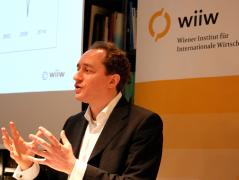wiiw Spring Forecast 2015-2017: A time of moderate expectations
13 March 2015
Growth in the CESEE region will follow the unimpressive pattern displayed by the euro area.
The longer-term convergence of income levels in the CESEE countries can no longer be expected to be as rapid as was assumed a decade or so ago. Growth in the period 2015-2017 is not going to deviate substantially from the pace recorded in 2014. For the new EU Member States growth is expected to remain slightly below 3% in the years to come. This implies an average growth differential of about 1.5 percentage points as compared to the euro area – about half of what it was before the global financial crisis. On the other hand, most of the countries in the region are also expected to evade the dangers of runaway inflation, fiscal deficits or excessive foreign borrowing that often plagued them in the past. These are the main results of the newly released medium-term growth forecast for the region by the Vienna Institute for International Economic Studies (wiiw).

Mario Holzner, wiiw Deputy Director
Depressed aggregate domestic demand has been the major factor behind anaemic growth. This is evidenced by disinflation (or even mildly deflationary tendencies) across much of the region, as well as the persistence of fairly high unemployment. There is some evidence of a ‘race to the bottom’ in terms of wage setting. While wage moderation strengthens profitability and external competitiveness, it also weakens disposable household incomes and thus slows down growth in domestic demand. Apparently, there is a trade-off between improvements in the trade balance and more rapid growth in domestic demand. Overall, GDP growth is being held ‘on a short leash’.
Growth in public investment may be supporting economic growth, especially in those new EU Member States (NMS) that have access to EU funds. However, a proper rebound in private-sector investment is still lacking. Weak private-sector investment cannot be attributed to a ‘profit squeeze’ in the corporate sector. On the contrary, the corporate sector has been doing very well, at least in those NMS for which relevant data are available. The corporate sector as a whole still tends to lend rather than borrow. The means available to the corporate sector appear to be plentiful at present – but the sector still prefers to lick its wounds inflicted by former excessive borrowing or extend loans (primarily to the public sector) rather than to invest productively. Loans are stagnant even in those instances where interest rates are relatively low. With a few exceptions (largely on the region’s periphery) the stocks of loans to the non-financial corporate sector increased marginally at best in 2014. This may reflect firms’ pessimistic assessment of future growth in demand, increased ‘liquidity preference’ or the relative abundance of the means at their disposal. Non-performing loans are linked to a high share of borrowing in foreign currencies. The recent strengthening of the Swiss franc will bear some negative consequences for those firms and households that borrowed heavily in that currency in the past.
New evidence supports the claim that the countries with floating exchange rates fare better in the medium to long term. They tend to avoid irreversible currency overvaluation, whereas the countries with fixed exchange rates do not quite avert it. It is argued, however, that despite the rigidity of the exchange rates, overvaluation can be avoided – at least in the medium term. All the CESEE countries are running up fiscal deficits. Current account deficits are still depressed. Net national lending in the NMS tends to be positive. This is a consequence of current savings in the private sector in the NMS generally running ahead of gross fixed capital formation in that sector.
On average, output growth across the NMS will become more uniform in 2015 – albeit not any faster. Average growth will remain at 2.7% in 2015. Some acceleration in marginal growth is to be expected in the biennium 2016-2017. Unemployment in the NMS will recede only gradually. Low inflation will prevail in 2015, but it will gradually return to more normal levels in 2016. Under sustained – albeit rather anaemic – growth, the current account balances will deteriorate (although they will still remain comparatively low).
Growth is hardly accelerating in the (current and potential) EU candidate countries either. Output in those countries is not expected to grow faster than in the NMS. Turkey, Macedonia and Kosovo may fare slightly better than the rest of the group, with growth rates of above 3% in 2015. However, with the exception of Turkey, those countries seem to have put high inflation behind them. Nonetheless, their unemployment figures continue to be dismal (less so only in Turkey). They will also run high (or even very high) current account deficits.
Most of the successor states to the Soviet Union will perform rather badly in 2015. Ukraine’s output will continue its free fall as many of the country’s industrial centres have become battlefields. A drop of 5% in economic growth is expected for 2015. The decline in world market prices for energy carriers will negatively affect both Kazakhstan and Russia, with real output in the latter country dropping sharply by almost 4% in 2015. A similar fate will befall Belarus: a country that relies heavily on exports to Russia and Ukraine. However, assuming a peaceful resolution to the Ukrainian conflict in 2015, it is expected that all the successor states will resume moderate growth in 2016 or 2017.
Press Releases
Related Presentations
- wiiw-Prognose für Mittel-, Ost- und Südosteuropa, 2015-2017: Verhaltene Erwartungen (press conference presentation in German)
- New wiiw forecast for Central, East and Southeast Europe, 2015-2017: A time of moderate expectations (press conference presentation in English)
